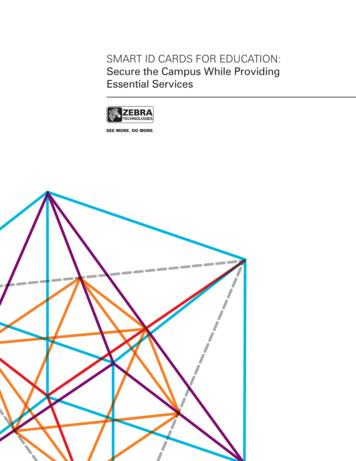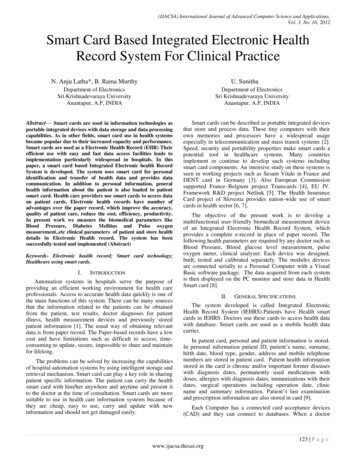
Transcription
SMART ID CARDS FOR EDUCATION:Secure the Campus While ProvidingEssential Services
EXECUTIVE SUMMARYFrom universities to primary schools, a revolution intechnology is taking shape. The days when mundanetasks such as registration, book purchases, and mealprograms required an army of administrators tomanage piles of paperwork is but a digital page intoday’s history e-books. Twenty-first-centuryinnovation is bringing automation—and a chance toimprove security—to the campus.With education costs skyrocketing, departments atall levels are looking for ways to do more with less—trimming expenses while maximizing staffproductivity. Add the looming threats to campussecurity, and educators must make decisions thatbalance quality of education with protecting ourstudents. In fact, the 2011 Campus Safety magazine’s“How Safe Is Your Campus?” report revealed that 52percent of faculty said their institutions fail todedicate sufficient resources to campus safety andsecurity.1The simple answer relies on the same technologythat corporations use—secure smart ID cards.Embedded with “smart” features such as radiofrequency identification (RFID) and tamper-resistantlaminates, education campuses can realize a widerange of benefits, from tightening security, tostreamlining admission, to improving paid services.Read on to find out how you can benefit from smartcards, and learn how your school district can do morewith less.INTRODUCTIONEDUCATION IS READY FOR THE SMART CARD REVOLUTIONEducators at all levels are seeking ways to leveragetechnology to improve the quality of learning, simplifyadministrative tasks, and protect students. However,leaner budgets, growing numbers of students, andrising per-student costs mean that schools mustimprove efficiency. Answering the challenge demandsinnovative solutions that automate facility and classaccess, improve campus security, and streamlinecampus services such as meal and library programs.In many ways, schools have been slow to adopttechnologies commonly used in the private businesssector to streamline operations. Student admission isstill a manual, time-consuming process at the majorityof primary education campuses. Institutions of highereducation campuses have adopted online admissions1and class registration, but students still must stop bythe main office and stand in line to pick up theiridentification cards.Inefficiencies from manual processes extend past thefirst week of school. Student tardiness is an ongoingissue. Students must stop by the office to pick uptheir handwritten tardy slips—and waste time betterspent doing class activities. While this may seemtrivial, many school districts depend on attendancenumbers to maintain their funding levels. Lessattendance means fewer dollars. Fortunately,advances in smart ID card technologies and thesurrounding infrastructure offer the optimal solutionfor streamlining administrative tasks.How Safe is Your Campus? Survey Results: Universities ety-Statistics/1481.aspxA Zebra Technologies White Paper2
SMART ACCESS CARDSWHAT THEY ARE, HOW THEY WORKThe Intelligence of Embedded RFIDThe term “smart access cards” in education, business,and government applications encompasses a widerange of technologies. The common feature of mostcontactless, proximity-based solutions relies onembedded high-frequency (HF) RFID technology. Mostcontact type ID cards use magnetic stripe technology,which means students must swipe their cards througha reader, slowing down student access and creatingbottlenecks. Magnetic stripe cards are also unreliablesince they are easily de-magnetized.Education access-card applications can benefit fromUHF Gen 2 RFID’s long-read range and fastidentification capabilities. Schools can eliminatesingle-file, one-at-a-time card reads. Groups ofstudents can move through large, open entry and exitpoints, rather than having to pass through narrowdoorways, gates or turnstiles.While conditions change in the business world,education facilities need solutions that can stand thetest of time—future-proofed to last a student’scampus tenure. Made from durable materials such aspolyester and PVC, secure ID cards can last the entireterm of a student’s education—saving the institutionthe recurring costs of annual card replacement.AN OPEN BOOK OF BENEFITSSECURITY, EFFICIENCY AND COST REDUCTIONJust imagine: one ID card for everything—and that isthe key point. Smart cards can serve as the foundationfor a wide range of applications, providingopportunities to streamline security and administrativetasks across the entire campus. The process startsduring student admission or when faculty/staff receiveA Zebra Technologies White Papertheir new hire orientation. It is here that the schoolissues a durable, smart ID card embedded with RFIDtechnology. Once an education district implementssmart ID cards, the technology serves as the idealfoundation for ongoing benefits, campus wide.3
TIGHTEN PHYSICAL SECURITY AND FACILITY ACCESSStudent, Staff and Visitor ManagementTime and Attendance TrackingSecurity is more than just ensuring that visitorscasually check in at the office. Protecting our studentsis becoming increasingly important. Other than hireenough security guards to police every facility andaccess point, what can education departments do toimprove security today?For many school districts, tracking the amount of timestudents spend performing class time is vital forplanning and funding. To improve security andincrease attendance rates, the Spring school district inHouston, Texas, has distributed RFID-enabled IDbadges to 13,500 of its 36,000 students sinceDecember 2008. The technology replaces the manualattendance tracking that faculty had to perform foreach class session and for each student.Throughout the nation, many colleges and universitiesuse visitor management systems to improve securityand protect students against unauthorized visitors andpeople posing as students. While visitor managementmay seem like an issue only for K-12 facilities, collegecampuses are an open environment, making it difficultto monitor activity.School security departments must know who is on thecampus at all times. The first step is to strictly enforcevisitor sign-in and issue the visitor a temporary RFIDenabled ID smart card that affords track-and-tracetechnologies. Upon sign-in, school visitor softwarecan also determine if the visitor is wanted by lawenforcement or registered in the sex offenderdatabase—creating a path back into law enforcement.Access Control for Secure Buildings or RoomsRFID-enabled smart cards present the optimal solutionfor not only visitor management, but access controlfor all people, campus wide. Issuing a smart ID card toall faculty, students, staff and visitors allows securitydepartments to control who has access to what,where and when. Campuses can improve dormitorysafety, secure labs with high-value equipment, andensure research departments performing specializedprojects only provide access to those with the rightcredentials.With RFID-enabled plastic card personalization andintegration of digital photo identification solutions,schools can move from a handwritten to anautomated approach. Smart access card solutionsdeliver a new level of accountability and enforcementthat can help reduce the number of tardies. This wiseinvestment of the school budget directly givesstudents more in-class time, while savingadministrative time and money.Streamline Library Access and InventoryManagementCampus libraries, printers and copy rooms shouldremain exclusive to students. With RFID card readersat the door, students entering the library or copy roomcan use their student ID to gain access. Students canthen check out books automatically, with allinformation recorded and loaded into the studentdatabase. This eliminates the need for library checkoutcards and provides real-time information on the statusof overdue books. Schools can use this information tolock students out of privileges until they return thebooks or deduct the book cost from the student’sdebit fund.Optimally, schools can integrate their enterpriseresource planning (ERP) system with the ID cardsystem. Doing so provides a single point ofmanagement for allowing or denying physical accessto students attending classes in different buildings.A Zebra Technologies White Paper4
EXPAND PAID SERVICESElectronic Payment for Food, Beverages andBookstoresWhile on campus, students not only fill their minds,but also their stomachs. Students can load their cardswith meal credits, allowing them to use their IDs like adebit card at vending machines and in dining halls. IDcards can include a pre-paid spending account thatstudents can use to make purchases at student storesand food service locations, as well as at schoolevents. Parents and students can access accountsonline to view transactions, add funds and establishautomatic allowances. The benefits extend wellbeyond food and beverage purchases. Students canalso use their smart ID cards to purchase books, payfor temporary parking on campus, and resolve parkingcitations.Expand Off-Campus Affiliate ProgramsThe large student populations at universities andcollege campuses fill the surrounding community witha captive consumer audience. Smart ID cards bringthe campus and community together to generatevalue-added opportunities for local stores, restaurantsand service providers. Students can use their cards onor off campus and accrue credits and incentives forfurther purchases. Affiliate programs can also extendoutside the local community into large franchises.When coupled with customer relationshipmanagement (CRM) databases, smart card purchasescan provide valuable data for marketing metrics,enhancing affiliate programs even further.TYING IT ALL TOGETHERSMART CARD PRINTING TECHNOLOGIESAll the access card technologies described in thispaper, including barcode, RFID, magnetic stripe, smartcard, graphics and photo security features, can beprinted on demand—wherever and whenever.Switching from pre-printed access cards, temporaryIDs and passes to on-demand identification printingsystems provides an immediate benefit by removingthe worries related to managing and securing costlymaterials.A Zebra Technologies White PaperA barcode is the most widely used data storageformat for security printing applications, and RFID isthe fastest growing. Common linear barcodes easilymeet most needs for encoding employee and visitoridentification. Two-dimensional (2-D) barcodes canencode significantly more text than linear codes andstore digitized photos, graphics, fingerprint files andother biometric data. Smart card RFID printingsolutions provide multiple encoding and securitytechnologies, including holograms and magneticstripes.5
CARD PRINTERSDigital plastic card printers offer the ability to createcustom cards tailored to the application, at the pointof issuance. System administrators can invalidate lostor stolen cards and issue replacements immediately.Unlike traditional ID card systems that lackedcustomization or required time-consuming photoprocessing, cutting, and laminating, today’s digitalprint-on-demand (POD) systems enable completelyautomated production of highly customized, securecards. A wide variety of card printers exist to meetuser needs, including high-duty cycle models forapplications that require thousands of cards annually,such as large universities.Digitally printed plastic cards provide numeroustechnological features but start with a blank plasticcard customizable with any combination of artwork,graphics, text, digital photographs, barcodes, logosand more. The printer can encode additional machinereadable information, such as magnetic stripes andsmart card chips. The image quality of plastic photo IDcards produced with digital printing technology is farsuperior and tamper resistant compared to thoseproduced through the traditional method of trimmingprinted photos and laminating them onto the card.Different card materials and laminates provideadditional protection from tampering.Magnetic stripe cards carry more data than standardbarcodes but require media that costs more. Cardissuers stock blank magnetic stripe cards and encodethem on demand. RFID-enabled smart cards can holdthe most data of any medium—up to 100 times morethan a magnetic stripe card—and often include aprocessor chip that enables multiple applications.CONCLUSIONMultifunction smart ID cards offer several easy andcost-effective ways for campuses to raise the level ofprotection and quality of education. Today’s smartaccess card technologies provide superior range andread performance so that educational institutions canimprove efficiency and security at multiple levels.A global leader respected for innovation andreliability, Zebra offers technologies that illuminateorganizations’ operational events involving theirassets, people and transactions, allowing them to seeopportunities to create new value. We call it theVisible Value Chain.Print-on-demand card printers can create securestudent and staff IDs so campuses can maintain asafe learning environment. With IDs ranging frombasic functionality to smart cards, schools canstreamline records management, simplify classregistration and attendance, and control access tosecure areas. Fast throughput of student ID cardsallows for on-demand, in-house printing to servestudents faster.Zebra’s extensive portfolio of marking and printingtechnologies, including barcode, RFID, GPS andsensoring, turns the physical into the digital to giveoperational events a virtual voice. This enablesorganizations to know in real-time the location,condition, timing and accuracy of the eventsoccurring throughout their value chain. Once theevents are seen, organizations can create new valuefrom what is already there.With smart ID cards and POD solutions, parents andfaculty alike can gain peace of mind that theirstudents and campuses remain protected. Educatorscan now do more with less, while creating newopportunities to enhance the educational experience.For more information about Zebra’s solutions, visitwww.zebra.com.A Zebra Technologies White Paper6
Corporate Headquarters 1 800 423 0442inquiry4@zebra.comAsia-Pacific Headquarters 65 6858 0722apacchannelmarketing@zebra.comEMEA Headquarters 44 (0)1628 556000mseurope@zebra.comLatin America Headquarters 1 847 955 2283inquiry4@zebra.comOther Locations / USA: California, Georgia, Illinois, Rhode Island, Texas, Wisconsin Europe: France, Germany, Italy, the Netherlands, Poland, Spain, Sweden, Turkey,United Kingdom Asia Pacific: Australia, China, Hong Kong, India, Indonesia, Japan, Malaysia, Philippines, Singapore, South Korea, Taiwan, Thailand, VietnamLatin America: Argentina, Brazil, Colombia, Florida (LA Headquarters in USA), Mexico Africa/Middle East: Dubai, South Africa 2013 ZIH Corp. All product names and numbers are Zebra trademarks, and Zebra and the Zebra head graphic are registered trademarks of ZIHCorp. All rights reserved. All other trademarks are the property of their respective owners.P1043262 (02/13)
may seem like an issue only for K-12 facilities, college campuses are an open environment, making it difficult to monitor activity. School security departments must know who is on the campus at all times. The first step is to strictly enforce visitor sign-in and issue the visitor a temporary RFID-enabled ID











